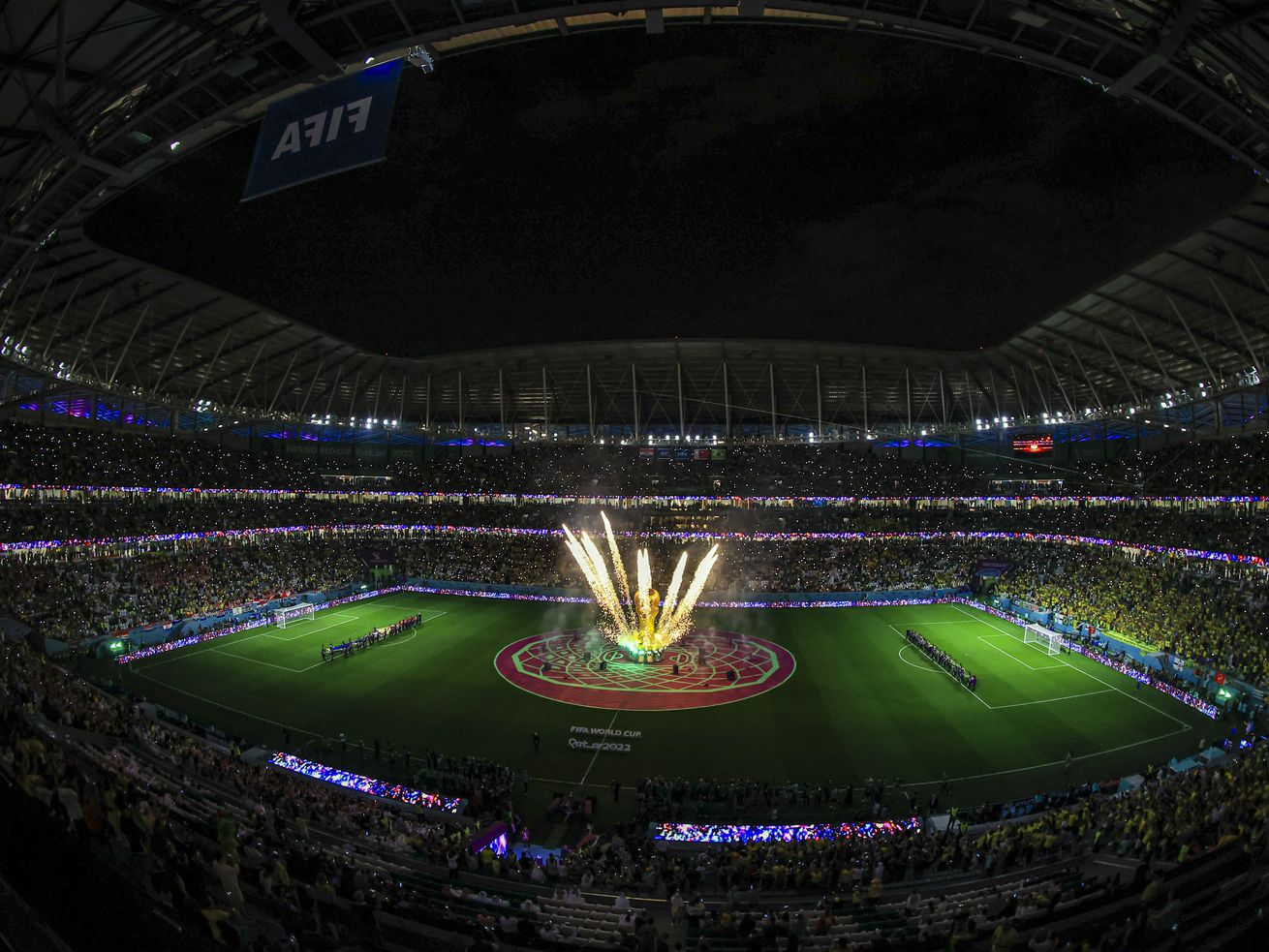Why we shouldn’t give up on reducing the climate impact of sports.
The 2022 FIFA World Cup has so far delivered on the promise of an exciting tournament with drama, upsets, and nail-biting finishes. However, organizers also promised that the soccer tournament in Qatar would be “the first carbon neutral FIFA World Cup in history.”
That endeavor seems to have fallen short. Independent outside assessments found that organizers have not balanced the books on the climate impacts of building new stadiums and a million people traveling from around the world to attend 64 matches. One estimate shows that FIFA has undercounted the emissions associated with new stadiums by a factor of eight.
FIFA, the governing body for international soccer, has been talking about making its tournaments carbon-neutral since at least 2006, when Germany hosted the World Cup. In August, organizers published a nearly 60-page report highlighting the sustainability measures it would pursue to reduce and offset all the greenhouse gas emissions associated with a massive international sporting event. In October, however, the nonprofit Carbon Market Watch put out a report assessing FIFA’s climate strategy for the World Cup and found that it underestimated the environmental impacts and used questionable tactics for offsetting the emissions that they did account for.
Now it seems that FIFA has quietly backed away from this goalpost. The website laying out the carbon-neutral pledge was offline as of December 8, but an archived copy shows that organizers were keen on making this a selling point for the most expensive World Cup ever, which has a price tag of more than $200 billion.
“When Qatar was awarded the right to stage the first FIFA World Cup™ in the Middle East and Arab world, it not only committed to organising an amazing tournament — but also a mega-event delivered in a sustainable manner,” reads the archived page.
That’s an ambitious target. Reducing the climate impacts of any major international event is going to be a massive challenge, and the world’s most-watched sports event was certainly going to invite extra scrutiny. “It was a mistake that they tried to make this an advertising strategy,” said Gilles Dufrasne, lead for global carbon markets at Carbon Market Watch.
The World Cup is only the latest in an environmental marketing trend in athletics. More sporting events are trying to grapple with their impacts on the climate, at least on paper. The Pac-12 Football Championship earlier this month claimed to be carbon-neutral. So did the Winter Olympics in Beijing earlier this year. The NFL says every Super Bowl since 2005 has balanced out its carbon emissions.
Under closer inspection, many of these claims wither. Most of them rely on the questionable tactic of buying carbon offsets rather than reducing emissions overall, and environmental activists often decry this approach as greenwashing. But as average temperatures around the world continue to rise, it’s worth asking what steps could meaningfully reduce the climate change impact from sports. Now that the World Cup is drawing to its final rounds, it could provide lessons for sporting events around the world, even if it misses its main goal by a wide margin.
Where the Qatar World Cup falls short on its climate claims
Hosting a soccer tournament at all in Qatar, a tiny desert country, was always going to be a challenge. But the runup to the 2022 World Cup was marred by controversy at every stage: bribery allegations, human rights abuses in the construction of the stadiums, changing the timing of the tournament from summer to winter in order to avoid Qatar’s searing summer heat. Curbing the current World Cup’s environmental footprint proved especially challenging given that there was little infrastructure in place.
“That was just fatally flawed from the beginning,” said Suki Hoagland, lecturer in the earth systems program at the Stanford Doerr School of Sustainability. “You could go back to when it was awarded and scratch your head and say, what were we thinking?”
Preparing for the tournament required building six new stadiums and one temporary facility. Organizers said one key way they’re reducing emissions is that the venues are within 30 miles of the capital, Doha, limiting the need for travel between matches. The stadiums themselves are deploying state-of-the-art energy-efficient lighting and cooling systems.
/cdn.vox-cdn.com/uploads/chorus_asset/file/24279896/GettyImages_1135528764.jpeg)
Nicola Sua/AMA/Getty Images
But most of the materials to build them were imported, adding to the carbon footprint. And it’s still a massive buildout for such a small country. The combined seating capacity is enough to seat the total number of Qatari citizens. Stadiums are thirsty, too. World Cup matches are played on grass, which in turn demands more than 2,000 gallons of water per day to keep verdant. Water is an especially precious commodity in a desert country, and much of Qatar’s freshwater comes from desalinated seawater, a process that demands lots of fossil fuels.
Dufrasne said that organizers have drastically underestimated the greenhouse gases associated with all the new construction by only accounting for their use over the month-long tournament rather than their lifetime. They also failed to adequately account for all the associated emissions of things needed to host fans from around the world, like hotels and transportation.
To compensate for the unavoidable emissions, organizers are purchasing carbon offsets. Such schemes have long been criticized for failing to deliver the greenhouse gas emissions they promise and have been plagued by dodgy accounting.
But Qatar’s offset scheme for the World Cup was particularly sketchy, as Ian Ward explained for Vox:
To offset the tournaments’ total emissions footprint, organizers will need to purchase approximately 3.6 million credits, half of which they have agreed to buy from a group called the Global Carbon Council. (So far, they’ve purchased fewer than 350,000 credits, according to their public disclosures.) But despite its name, Global Carbon Council is not, in fact, an international institution. Instead, it’s based in Qatar and is connected to Qatari state-owned entities.
Qatar’s in-house carbon credit scheme makes it harder to verify that they are actually delivering results, and in many instances, it appears that they aren’t. Some of the credits are going toward new renewable energy projects that are already underway rather than spurring construction that would not have occurred otherwise. As a result, the tournament’s claim of being carbon-neutral doesn’t hold up.
“It’s a very definitive statement that isn’t supported by the evidence,” Dufrasne said. “I was a bit surprised by how bad it was.”
Can you ever make a carbon-neutral sports tournament?
Despite the environmental shortfalls of the Qatar World Cup and other major tournaments in recent years, trying to eliminate the climate change impact of sports is still a laudable goal. “I would hate to see us abandon that goal because it’s hard,” Hoagland said. “I don’t want to give these mega events a pass.”
Conversely, if organizers can figure out how to drastically reduce the greenhouse gas emissions from the travel, construction, and festivities around major international gatherings, the benefits and the learning from those experiences would ripple throughout the world.
The key to the strategy, according to Hoagland, is to factor in climate change from the outset rather than cast it as a problem to be addressed at the end. That can shape where tournaments are held, selecting for sites that already have facilities and are more centrally located, minimizing the emissions associated with construction and travel. From there, organizers can plan the logistics of housing, feeding, and moving fans.
/cdn.vox-cdn.com/uploads/chorus_asset/file/24279904/GettyImages_1243940900.jpeg)
AFP via Getty Images
This runs counter to the pitch that hosting events like the Olympics offers countries a chance to invest in infrastructure and boost their economies. But real-world experience in places like Brazil that have hosted the Olympics and the World Cup shows that many of the facilities are left unused after the event. Many cities and countries end up losing money on hosting these tournaments unless they already have the stadiums, dorms, hotels, buses, and trains in place.
Reducing the climate impact of sports also has to focus foremost on reducing emissions. There is no substitute for actually preventing carbon dioxide from entering the air in the first place. Offsets should only be a marginal part of the climate strategy for something like the Olympics or the World Cup, if at all. Travel, not just by the athletes but also the fans, is one of the biggest sources of greenhouse gas emissions from sports, so that is a key opportunity.
The past two years of sports have also created some useful experiments amid the Covid-19 pandemic. The NBA, for instance, played much of the 2020 season in a “bubble” in Orlando, Florida, as a way to keep playing without exposing teams to infection. The Tokyo Olympics in 2021 marked the first time the event was held without in-person spectators, though organizers said more than 3 billion viewers watched remotely. Baseball games were played with fake fans in the stands. While the games went on, the limited audiences highlighted just how hard it is to keep playing in isolation.
“Sport is a social thing,” said Brian McCullough, an associate professor of sports management at Texas A&M University. “To actually be there, for whatever sporting event, is really special and that creates that intangible experience that we are all seeking.”
But the pandemic also showed that leagues can be a lot more flexible in their timing and venues, and that teams would benefit from a less punishing travel schedule. Leagues like the NBA and MLB are already working to optimize schedules for teams to reduce travel using tactics like scheduling regional matchups closer together.
Some tidbits about the NBA schedule for the 2022-2023 season pic.twitter.com/PDpvcX4S98
— Mark Medina (@MarkG_Medina) August 17, 2022
But there are countercurrents to this as well. There’s more pressure for professional athletes to travel over more of the world to reach broader audiences. The NFL has already played matches in the UK, Germany, and Mexico this season. The NBA has games in France, the Middle East, and Japan. Even college athletes are being pushed to travel farther. The Big 10, once an athletic conference of colleges in the Midwest, will soon stretch from California to New Jersey.
The very spectacle of sports, however, might yield the biggest benefits for the climate. With millions of people watching, efforts to reduce greenhouse gas emissions could raise awareness of all the tactics that are out there and highlight the tangible benefits to individuals like saving money. Teams in Arizona could tailor their environmental messages differently from teams in Minnesota to better appeal to their respective audiences.
“It doesn’t always have to lead with saving the world,” McCullough said.
The athletes themselves can also be messengers and reach audiences that might not otherwise be receptive to mitigating climate change. Winter sports athletes in particular have long been raising the alarm about how climate change will reduce opportunities to ski, skate, and snowboard. The International Olympic Committee is considering limiting the Winter Olympics to a rotating handful of host cities as the ideal winter conditions become scarcer.
For the World Cup, the challenge is only growing. The 2026 tournament will host 48 teams instead of the current 32 and will be played across Mexico, the US, and Canada. That means the climate footprint could be massive unless organizers start planning now to keep their emissions in check. It’s a tough challenge, but limiting warming will help keep pitches green and sports accessible to people around the world.
Author: Umair Irfan
Read More



